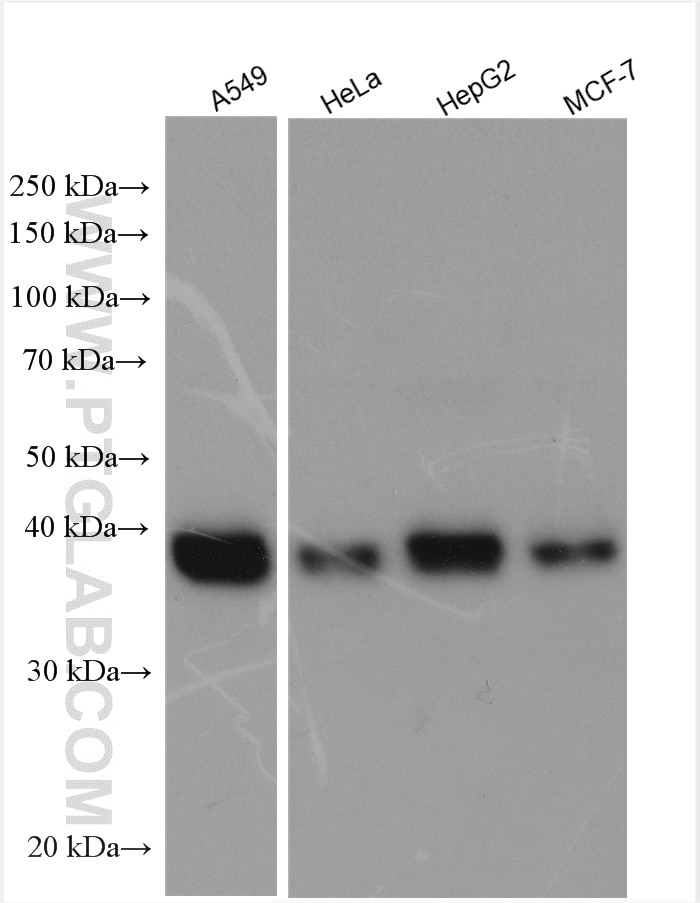Validation Data Gallery
Tested Applications
Recommended dilution
| Application | Dilution |
|---|---|
| It is recommended that this reagent should be titrated in each testing system to obtain optimal results. | |
| Sample-dependent, Check data in validation data gallery. | |
Published Applications
| KD/KO | See 1 publications below |
| WB | See 1 publications below |
| IF | See 1 publications below |
Product Information
10535-1-AP targets B4GALT7 in WB, IF, ELISA applications and shows reactivity with human samples.
| Tested Reactivity | human |
| Cited Reactivity | human |
| Host / Isotype | Rabbit / IgG |
| Class | Polyclonal |
| Type | Antibody |
| Immunogen |
CatNo: Ag0793 Product name: Recombinant human B4GALT7 protein Source: e coli.-derived, PGEX-4T Tag: GST Domain: 1-327 aa of BC007317 Sequence: MFPSRRKAAQLPWEDGRSGLLSGGLPRKCSVFHLFVACLSLGFFSLLWLQLSCSGDVARAVRGQGQETSGPPRACPPEPPPEHWEEDASWGPHRLAVLVPFRERFEELLVFVPHMRRFLSRKKIRHHIYVLNQVDHFRFNRAALINVGFLESSNSTDYIAMHDVDLLPLNEELDYGFPEAGPFHVASPELHPLYHYKTYVGGILLLSKQHYRLCNGMSNRFWGWGREDDEFYRRIKGAGLQLFRPSGITTGYKTFRHLHDPAWRKRDQKRIAAQKQEQFKVDREGGLNTVKYHVASRTALSVGGAPCTVLNIMLDCDKTATPWCTFS 相同性解析による交差性が予測される生物種 |
| Full Name | xylosylprotein beta 1,4-galactosyltransferase, polypeptide 7 (galactosyltransferase I) |
| Calculated molecular weight | 37 kDa |
| Observed molecular weight | 37 kDa |
| GenBank accession number | BC007317 |
| Gene Symbol | B4GALT7 |
| Gene ID (NCBI) | 11285 |
| RRID | AB_2274457 |
| Conjugate | Unconjugated |
| Form | |
| Form | Liquid |
| Purification Method | Antigen affinity purification |
| UNIPROT ID | Q9UBV7 |
| Storage Buffer | PBS with 0.02% sodium azide and 50% glycerol{{ptg:BufferTemp}}7.3 |
| Storage Conditions | Store at -20°C. Stable for one year after shipment. Aliquoting is unnecessary for -20oC storage. |
Background Information
B4GALT7 (Beta-1,4-galactosyltransferase 7), also known as galactosyltransferase I, is involved in the formation of proteoglycans which are components of the extracellular matrix in connective tissues (PubMed: 10438455). The reduced activity of B4GALT7 results in delayed wound repair, altered migration, adhesion and contractility of patient fibroblasts (PMID: 16583246, PMID: 18158310). Mutations in B4GALT7 that also result in Spondylodysplastic (PMID: 24755949, PMID: 12417421).
Protocols
| Product Specific Protocols | |
|---|---|
| WB protocol for B4GALT7 antibody 10535-1-AP | Download protocol |
| Standard Protocols | |
|---|---|
| Click here to view our Standard Protocols |
Publications
| Species | Application | Title |
|---|---|---|
Eur J Hum Genet Impairment of glycosaminoglycan synthesis in mucopolysaccharidosis type IIIA cells by using siRNA: a potential therapeutic approach for Sanfilippo disease.
| ||

